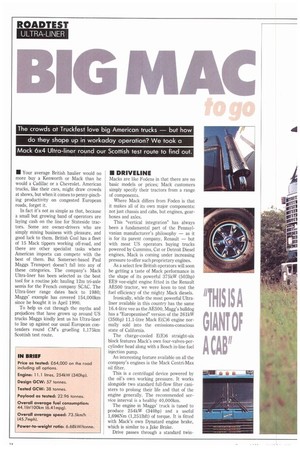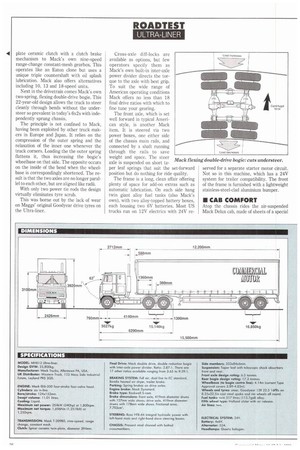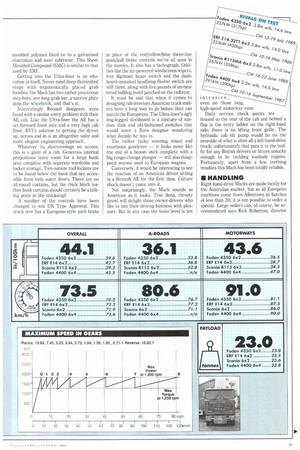• Your average British haulier would no more buy a
Page 26

Page 28

Page 29

If you've noticed an error in this article please click here to report it so we can fix it.
Kenworth or Mack than he would a Cadillac or a Chevrolet. American trucks, like their cars, might draw crowds at shows, but when it comes to penny-pinching productivity on congested European roads, forget it.
In fact it's not as simple as that, because a small but growing band of operators are laying cash on the line for Stateside tractors. Some are owner-drivers who are simply mixing business with pleasure, and good luck to them. British Coal has a fleet of 15 Mack tippers working off-road; and there are other specialist tasks where American imports can compete with the best of them. But Somerset-based Paul Maggs Transport doesn't fall into any of these categories. The company's Mack Ultra-liner has been selected as the best tool for a routine job: hauling 12m tri-axle semis for the French company SCAC. The Ultra-liner range dates back to 1980; Maggs' example has covered 154,000km since he bought it in April 1990.
To help us cut through the myths and prejudices that have grown up around US trucks Maggs kindly lent us his Ultra-liner to line up against our usual European contenders round CM's gruelling 1,175km Scottish test route. • DRIVELINE
Macks are like Fodens in that there are no basic models or prices; Mack customers simply specify their tractors from a range of components.
Where Mack differs from Foden is that it makes all of its own major components: not just chassis and cabs, but engines, gearboxes and axles.
This "vertical integration" has always been a fundamental part of the Pennsylvanian manufacturer's philosophy — as it is for its parent company, Renault — but with most US operators buying trucks powered by Cummins, Cat or Detroit Diesel engines, Mack is coming under increasing pressure to offer such proprietary engines.
As a select few British operators will soon be getting a taste of Mack performance in the shape of its powerful 375kW (503hp) EE9 vee-eight engine fitted in the Renault AE500 tractor, we were keen to test the fuel efficiency of the mighty Mack diesels.
Ironically, while the most powerful Ultraliner available in this country has the same 16.4-litre vee as the AE500, Magg's bulldog has a "Europeanised" version of the 261kW (350hp) 11.1-litre Mack E(C)6 engine normally sold into the emissions-conscious state of California.
The charge-cooled E(E)6 straight-six block features Mack's own four-valves-percylinder head along with a Bosch in-line fuel injection pump.
An interesting feature available on all the company's engines is the Mack Centri-Max oil filter.
This is a centrifugal device powered by the oil's own working pressure. It works alongside two standard full-flow filter canisters to prolong their life and that of the engine generally. The recommended service interval is a healthy 40,000km.
The engine in Maggs' truck is tuned to produce 254kW (340hp) and a useful 1,696Nm (1,2511bft) of torque. It is fitted with Mack's own Dynatard engine brake, which is similar to a Jake Brake.
Drive passes through a standard twin plate ceramic clutch with a clutch brake mechanism to Mack's own nine-speed range-change constant-mesh gearbox. This operates like an Eaton clone but uses a unique triple countershaft with oil splash lubrication. Mack also offers alternatives including 10, 13 and 18-speed units.
Next in the drivetrain comes Mack's own two-spring, flexing double-drive bogie. This 22-year-old design allows the truck to steer cleanly through bends without the understeer so prevalent in today's 6x2s with independently sprung chassis.
The principle is not confined to Mack, having been exploited by other truck makers in Europe and Japan. It relies on the compression of the outer spring and the relaxation of the inner one whenever the truck corners. Loading the the outer spring flattens it, thus increasing the bogie's wheelbase on that side. The opposite occurs on the inside of the bend when the wheelbase is correspondingly shortened. The result is that the two axles are no longer parallel to each other, but are aligned like radii.
With only two power tie rods the design virtually eliminates tyre scrub.
This was borne out by the lack of wear on Maggs' original Goodyear drive tyres on the Ultra-liner. Cross-axle dill-locks are available as options, but few operators specify them as Mack's own built-in inter-axle power divider directs the torque to the axle with best grip. To suit the wide range of American operating conditions Mack offers no less than 18 final drive ratios with which to fine tune your gearing. Mack fleyri The front axle, which is set well forward in typical American style, is another Mack item. It is steered via two power boxes, one either side of the chassis main rails, and connected by a shaft running through the rails to save weight and space. The steer axle is suspended on short taper leaf springs that suit the set-forward position but do nothing for ride quality.
The frame is a long, clean affair offering plenty of space for add-on extras such as automatic lubrication. On each side hang twin giant alloy fuel tanks (also Mack's own), with two alloy-topped battery boxes, each housing two 6V batteries. Most US trucks run on 12V electrics with 24V re
served for a separate starter motor circuit. Not so in this machine, which has a 24V system for trailer compatibility. The front of the frame is furnished with a lightweight stainless-steel-clad aluminium bumper.
• CAB COMFORT
Atop the chassis rides the air-suspended Mack Delux cab, made of sheets of a special
moulded polymer fixed on to a galvanised aluminium and steel subframe. This Sheet Moulded Compound (SMC) is similar to that used by ERF.
Getting into the Ultra-liner is an education in itself. Never mind deep illuminated steps with ergonomically placed grab handles, the Mack has two rather precarious step bars, one long grab bar, a narrow plate atop the wheelarch, and that's it.
Interestingly Renault designers were faced with a similar entry problem with their AE cab. Like the Ultra-liner the AE has a set-forward front axle and a very high cab floor. RVI's solution to getting the driver up, across and in is an altogether safer and more elegant engineering approach.
Whatever its shortcomings on access, this is a giant of a cab. Generous internal proportions leave room for a large bunk area complete with separate wardrobe and locker storage. Two outsize tool lockers are to be found below the bunk that are accessible from twin outer doors. There are no all-round curtains, but the thick black leather bunk curtains should certainly be a talking point at the truckstopl A number of the controls have been changed to win UK Type Approval. This truck now has a European-style park brake in place of the red/yellow/blue three-line push/pull brake controls we've all seen in the movies. It also has a tachograph. Oddities like the air-powered windscreen wipers, foot dip/main beam switch and the dashboard-mounted headlamp flasher switch are still there, along with five pounds of un-neutered bulldog motif perched on the radiator.
It must be said that when it comes to designing cab interiors American truck makers have a long way to go before they can match the Europeans. The Ultra-liner's ugly dog-legged dashboard is a mixture of random dials and old-fashioned switches that would leave a Euro designer wondering what decade he was in.
The rather tacky steering wheel and enormous gearlever it looks more like the end of a broom stick complete with a big range-change plunger will also disappoint anyone used to European wagons.
Conversely, it would be interesting to see the reaction of an American driver sitting in a Renault AE for the first time. Culture shock doesn't come into it.
Not surprisingly, the Mack sounds as American as it looks. That deep, throaty growl will delight those owner-drivers who like to mix their driving business with pleasure. But in any case the noise level is not
............................. .. CM 16-22 Joite 1988. 29/kW (390hp/
Fodor) 4400 6>t4 3.2mlitre
..................................................
in.
even on those long,
......... high-speed motorway runs.
Daily service check points are
housed to the rear of the cab and behind a flap in the entry ladder on the right-hand side; there is no lifting front grille. The hydraulic cab tilt pump would be on the nearside of what is after all a left-hand-drive truck; unfortunately that puts it in the traffic for any British drivers or fitters unlucky enough to be tackling roadside repairs. Fortunately, apart from a few teething troubles this Mack has been totally reliable.
• HANDLING
Right-hand-drive Macks are made locally for the Australian market, but as all European machines come from Allentown in batches of less than 20, it is not possible to order a special. Large orders can, of course, be accommodated says Rick Roberton, director








































































